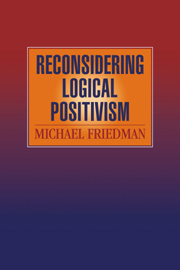Book contents
- Frontmatter
- Contents
- Foreword
- PREFACE
- INTRODUCTION
- Part One Geometry, Relativity, and Convention
- Part Two Der logische Aufbau der Welt
- Part Three Logico-Mathematical Truth
- 7 Analytic Truth in Carnap's Logical Syntax of Language
- 8 Carnap and Wittgenstein's Tractatus
- 9 Tolerance and Analyticity in Carnap's Philosophy of Mathematics
- Bibliography
- Index
9 - Tolerance and Analyticity in Carnap's Philosophy of Mathematics
Published online by Cambridge University Press: 05 June 2012
- Frontmatter
- Contents
- Foreword
- PREFACE
- INTRODUCTION
- Part One Geometry, Relativity, and Convention
- Part Two Der logische Aufbau der Welt
- Part Three Logico-Mathematical Truth
- 7 Analytic Truth in Carnap's Logical Syntax of Language
- 8 Carnap and Wittgenstein's Tractatus
- 9 Tolerance and Analyticity in Carnap's Philosophy of Mathematics
- Bibliography
- Index
Summary
In The Logical Syntax of Language, Carnap attempts to come to terms philosophically with the debate in the foundations of logic and mathematics that raged throughout the 1920s'the debate, that is, between the three foundational schools of logicism, formalism, and intuitionism. Carnap himself, as a student of Frege, Russell, and Wittgenstein, is of course most sympathetic to the logicist school. Nevertheless, he recognizes that traditional logicism cannot succeed: we cannot reduce mathematics to logic in some antecedently understood sense, whether in the sense of Frege's Begriffsschrift or Whitehead and Russell's Principia Mathematica. And, at the same time, Carnap is sensitive to the contributions, both technical and philosophical, of the two competing schools. In particular, he is sensitive to the notion of constructibility emphasized by the intuitionist school and, especially, to Hilbert's conception of metamathematics emphasized by the formalist school. Indeed, Carnap begins Logical Syntax by explaining that the meta-language, where we speak about the formulas and rules of a logical system, represents “what is essential in logic” (Foreword). The point of Carnap's book is then to develop a precise and exact method, logical syntax, wherein these “sentences about sentences” can be formulated.
Nevertheless, Carnap by no means shares Hilbert's foundational program. Carnap is fully cognizant, in particular, of Gödel's recently discovered incompleteness theorems and accordingly states explicitly that “whether … Hilbert's aim can be achieved at all, must be regarded as at best very doubtful in view of Gödel's researches on the subject” (§34!).
Information
- Type
- Chapter
- Information
- Reconsidering Logical Positivism , pp. 198 - 234Publisher: Cambridge University PressPrint publication year: 1999
Accessibility standard: Unknown
Why this information is here
This section outlines the accessibility features of this content - including support for screen readers, full keyboard navigation and high-contrast display options. This may not be relevant for you.Accessibility Information
- 8
- Cited by
